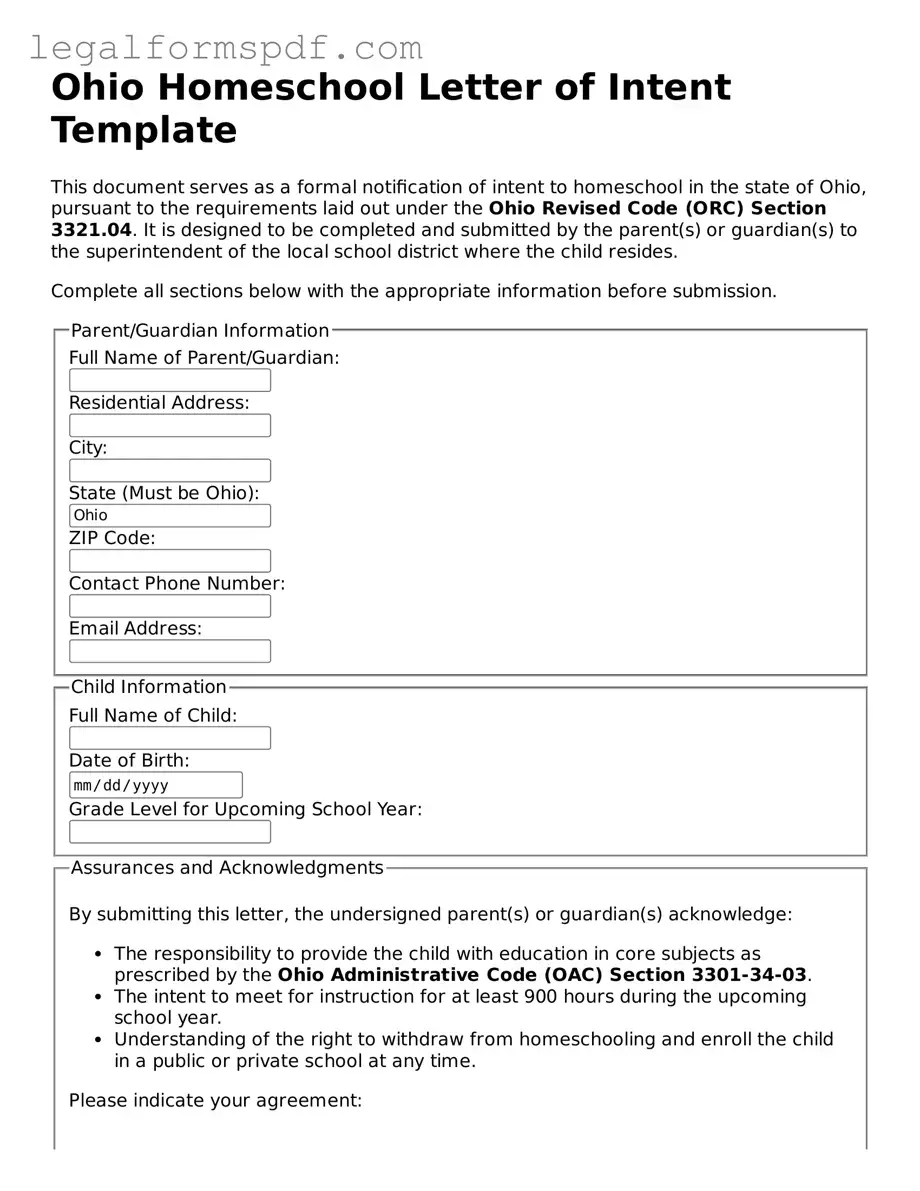The Ohio Homeschool Letter of Intent form bears similarity to a Private School Enrollment Notification form in several ways. Both documents serve as official notices to a governing body — in the case of homeschooling, it's typically a local school district, while private schools notify a state education department or similar entity. They communicate the intent to educate children outside the public school system, providing key details about the instructional environment. The main purpose of both forms is to ensure compliance with state education laws and regulations.
Another document akin to the Ohio Homeschool Letter of Intent form is the Educational Plan Proposal required in some states for homeschooling. This proposal often details the curriculum and instructional objectives for the homeschooling year ahead. Like the Letter of Intent, it's a forward-looking document that outlines the educational environment and goals for the student, ensuring they align with educational standards and requirements. This ensures that the child’s education will be recognized under state laws.
Student Registration forms used by both public and private schools also share similarities with the Ohio Homeschool Letter of Intent form. These forms are typically required for enrolling a student in a new school and include vital information about the student, their guardians, and their educational background. While serving different schooling environments, both types of documents formally recognize the student's educational setting and ensure their information is recorded for legal and administrative purposes.
The Declaration of Intent to Homeschool form, required in some jurisdictions, is very similar to the Ohio form. Both declare the parents' or guardians' intention to educate their child outside of the traditional public or private school systems. Typically, these documents ask for information about the child, the educational setting, and sometimes the curriculum to be used. The key purpose here is to notify the appropriate authorities of the child's educational status, ensuring the homeschooling setup meets legal standards.
The Notice of Termination of Homeschooling is somewhat a reverse counterpart to the Letter of Intent. While the Letter of Intent announces the start of homeschooling, the Notice of Termination is submitted when a child is transitioning out of homeschooling into another educational environment. Despite their different directions, both documents facilitate the legal and administrative transition of a student's educational status, ensuring compliance with state regulations.
Annual Assessment Reports, required in some states for homeschooling families, parallel the Ohio Homeschool Letter of Intent in their administrative role. These reports evaluate the child's academic progress over the school year, often including test scores or a portfolio of work as evidence. Although the Letter of Intent is more about intentions and plans for education, both forms play crucial roles in maintaining educational standards and complying with oversight requirements.
An Application for Educational Benefits might also be considered similar. This form, often used by families in traditional schooling environments, applies for programs like free or reduced lunch. While primarily financial rather than educational in content, it similarly requires detailed information about the student’s schooling situation and family circumstances. Both this application and the Letter of Intent ensure that students' needs are appropriately recognized and met within the educational framework.
Overall, the Ohio Homeschool Letter of Intent form shares key characteristics with various educational and legal documents, all designed to ensure children receive a compliant and recognized form of education suited to their needs. These documents, while varying in specifics, collectively support the diverse educational decisions families make and facilitate compliance with educational standards and requirements.
